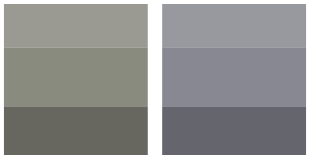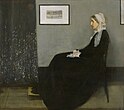Grey (more common in British English) or gray (more common in American English) is an intermediate color between blackand white. It is a neutral or achromatic color, meaning literally that it is "without color", because it can be composed of black and white.[2] It is the color of a cloud-covered sky, of ash and of lead.[3]
The first recorded use of grey as a color name in the English language was in 700 CE.[4] Grey is the dominant spelling in European and Commonwealth English. Gray has been the preferred spelling in American English.
In Europe and North America, surveys show that grey is the color most commonly associated with neutrality, conformity, boredom, uncertainty, old age, indifference, and modesty. Only one percent of respondents chose it as their favorite color.[5]
Optics[edit]
Over the centuries, artists have traditionally created grey by mixing black and white in various proportions. They added a little red to make a warmer grey, or a little blue for a cooler grey. Artists could also make a grey by mixing two complementary colors, such as orange and blue.
Today the grey on televisions, computer displays, and telephones is usually created using the RGB color model. Red, green, and blue light combined at full intensity on the black screen makes white; by lowering the intensity, it is possible to create shades of grey.
In printing, grey is usually obtained with the CMYK color model, using cyan, magenta, yellow, and black. Grey is produced either by using black and white, or by combining equal amounts of cyan, magenta, and yellow. Most greys have a cool or warm cast to them, as the human eye can detect even a minute amount of color saturation. Yellow, orange, and red create a "warm grey". Green, blue, and violet create a "cool grey".[14] When no color is added, the color is "neutral grey", "achromatic grey", or simply "grey". Images consisting wholly of black, white and greys are called monochrome, black-and-white, or greyscale.
 | |
| Warm grey | Cool grey |
| Mixed with 6% yellow. | Mixed with 6% blue. |
- RGB model
- Grey values result when r = g = b, for the color (r, g, b)
- CMYK model
- Grey values are produced by c = m = y = 0, for the color (c, m, y, k). Lightness is adjusted by varying k. In theory, any mixture where c = m = y is neutral, but in practice such mixtures are often a muddy brown (see discussion on this topic).
- HSL and HSV model
- Achromatic greys have no hue, so the h code is marked as "undefined" using a dash: --; greys also result whenever s is 0 or undefined, as is the case when v is 0 or l is 0 or 1
|
| Grey/Gray | |
|---|---|
| Hex triplet | #808080 |
| sRGBB (r, g, b) | (128, 128, 128) |
| CMYKH (c, m, y, k) | (0, 0, 0, 50) |
| HSV (h, s, v) | (0°, 0%, 50%) |
| CIELChuv (L, C, h) | (54, 0, 0°) |
| Source | HTML/CSS[1] |
| B: Normalized to [0–255] (byte) H: Normalized to [0–100] (hundred) | |





No comments:
Post a Comment